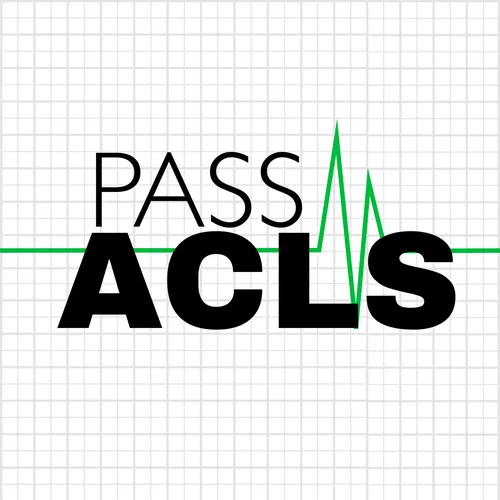
Pass ACLS Tip of the Day
I'm Paul from PassACLS.com and I'm here to help you pass ACLS. Like an audio flash card, this podcast is intended to aid any medical professional preparing for an Advanced Cardiovascular Life Support (ACLS) class. Each three-to-nine minute episode covers one of the skills needed to recognize a stroke or cardiac emergency and work as a high performing team to deliver safe, quality patient care.
Listening to a tip a day for a few weeks prior to your ACLS class will help cement the core concepts that have been shown to improve outcomes in patients suffering a heart attack, cardiac arrest, or stroke. In addition to the Chain of Survival, core concepts, and ACLS algorithms; specific information needed to pass the written exam, BLS checks, and megacode following the 2020 guidelines is presented.
Healthcare providers that are already ACLS certified, but rarely participate in codes, may find listening a helpful reminder.
Disclaimer: This podcast is a supplement to your course's approved text book and videos - not a replacement. The information presented is for educational purposes only, is intended for medical professionals, and is not medical advice. Medical professionals should follow their local laws, agency protocols, and act only within their scope of practice.
- Update frequency
- every day
- Average duration
- 5 minutes
- Episodes
- 81
- Years Active
- 2025

Oxygen Administration and SaO2 Monitoring
When treating patients with Acute Coronary Syndrome (ACS), MONA is an acronym sometimes used to help us remember the initial interventions.
The O in MONA is Oxygen.
When we should administer oxygen to …

Objective Measures of High Quality CPR
Along with early defibrillation, high quality CPR with minimal interruptions is one of the two factors that has been shown to improve cardiac arrest outcomes.
How do we know if high quality, effective…

Atropine & Dopamine for Unstable Bradycardia
When we should use the bradycardia algorithm.
The signs & symptoms of unstable bradycardia.
Atropine's bradycardic dose and maximum.
The use of atropine when a patient is in a second degree type II o…

Oropharyngeal Airway (OPA) Review
The tongue is the most common airway obstruction in an unconscious patient.
Insertion an oropharyngeal airway helps keep the patient’s tongue from falling to the back of the pharynx, causing an airway…

Hypoxia: An H&T Reversible Cause of Cardiac Arrest
Hypoxia is a state of low oxygen levels in the blood.
Determining hypoxia using a pulse oximeter or arterial blood gasses (ABGs).
A goal of ACLS is to recognize signs of hypoxia and provide timely trea…

Supraventricular Tachycardia (SVT)
ECG characteristics of supraventricular tachycardia (SVT) vs. sinus tachycardia.
Signs & symptoms that indicate a patient is unstable.
Delivery of a synchronized shock for the treatment of unstable SVT…

Epinephrine Administration During Cardiac Arrest
When working to resuscitate a patient in sudden cardiac arrest, Epinephrine is the first IV medication we administer.
When we give the first dose of epinephrine depends on whether the patient is in a …

Common Conditions That Can Mimic a Stroke
If a person suddenly develops symptoms such as weakness, slurred or garbled speech, loss of balance, or a massive & severe headache; it’s possible they could be having a stroke.
The Cincinnati Prehosp…

IO & ETT Medication Administration
Most ACLS medications are given IV push. But, what happens if we can't get an IV?
Why IO is better than ETT as an alternative route.
The locations we should place an IO when running a code and a locat…

EMS and Transportation to the Most Appropriate Facility
The chain of survival for a cardiac emergency and stroke start the same:
1. preparedness & recognition of an emergency;
2. activation of EMS;
3. delivery of Advanced Life Support; and
4. transporting…

Automated External Defibrillator (AED) Review
Performing good CPR and delivering a shock as soon as possible to a patient in Ventricular Fibrillation or pulseless V-Tach are the two most critical interventions that have been shown to increase s…

Asystole & Pulseless Electrical Activity (PEA) Algorithm
For apneic patients without a carotid pulse or patients with only gasping/agonal respirations, we will follow the Adult Cardiac Arrest algorithm.
For pulseless patients that the AED doesn't advise a …

CPR Songs
Providing good, high-quality CPR with minimal interruptions and early defibrillation are two key interventions shown to improved cardiac arrest outcomes.
A training tool used in many CPR and ACLS clas…

Obtaining a Medical History
A patient’s medical history will help us identify things that may be causing (or contributing) to their current condition as well as guide our decisions so we provide the safest evidence-based care p…

Antiarrhythmics: Magnesium and Procainamide
Although magnesium can be used in the treatment of other medical conditions such as eclampsia, asthma, & digitalis toxicity; for ACLS, magnesium is primarily used to treat Torsades de Pointes.
Identif…

Hypovolemia as a H&T Cause of Cardiac Arrest
When a patient loses excessive amounts of fluids, we say that they are in a state of hypovolemia.
The most obvious cause of hypovolemia is from bleeding.
Bleeding can be internal or external and caused…

Medication Review: Morphine
MONA is the acronym sometimes used to help us remember the interventions to consider for patients with Acute Coronary Syndrome.
Morphine's use in the Acute Coronary Syndrome (ACS) algorithm.
Why Morphi…

Maintaining a Chest Compression Fraction (CCF) Above 80%
Even good CPR is far less efficient at circulating blood than a functioning heart.
The indicators of high-quality CPR that were identified at the 2012 AHA CPR Quality
Summit in order of importance incl…

Medication Review: Epinephrine and Dopamine
Epinephrine and Dopamine are adrenergic agonist used in several ACLS algorithms.
The use of epinephrine for severe anaphylaxis and unstable bradycardia.
Review epinephrine’s effects on blood vessels an…

Providing High Quality Ventilations
Providing rescue breathing to apneic patients with a palpable pulse.
Normal end tidal CO2 for patients with a pulse.
Identification of cardiac arrest and our immediate actions.
Providing artificial vent…